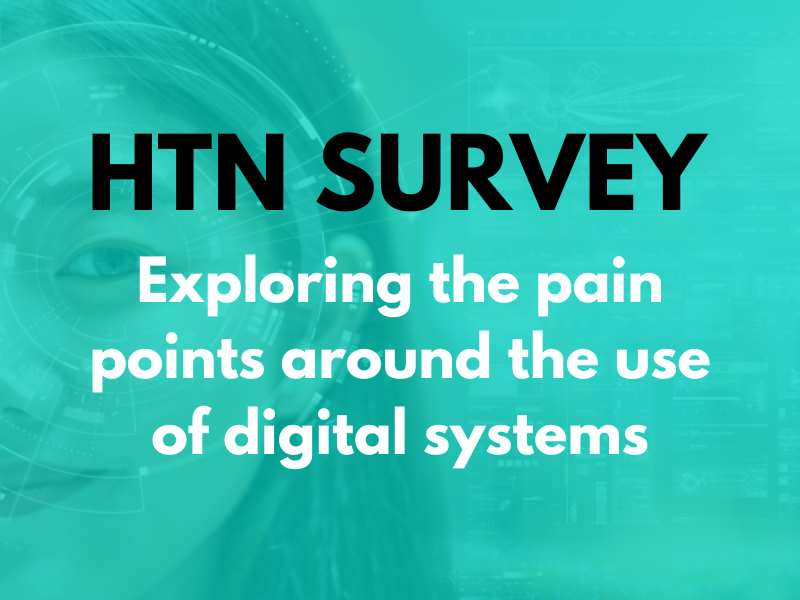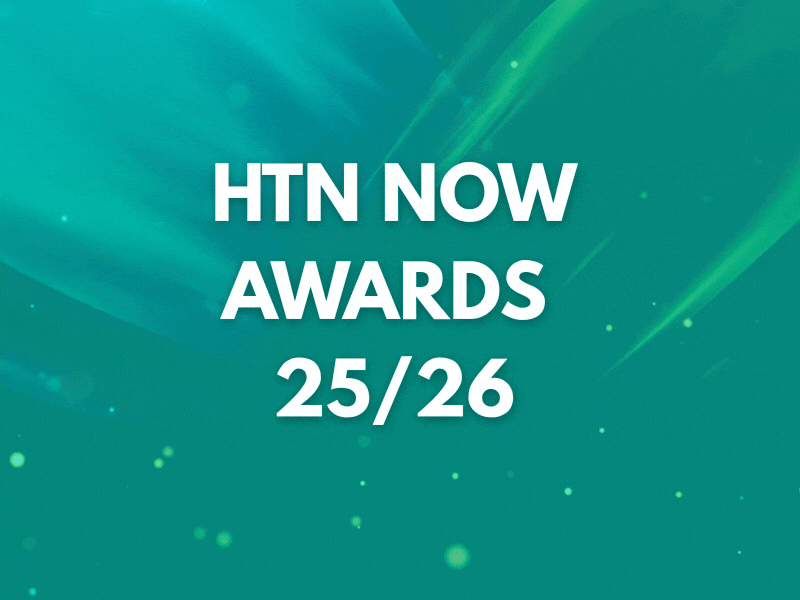Last month, HTN took a trip to London to attend The HETT Show: Healthcare Excellence Through Technology.
With stands, speakers, panels and more on everything to do with digital health from apps to analytics to case studies, there was plenty to learn from. In this second part of a two-part feature, we’ll share some of our highlights.
The NHS clinicians driving innovation: a panel led by Dr Tamsin Brown (Paediatrician and innovator of HearGlueEar), Gary Hawkins (Nurse and innovator of NEBS), Saran Mutguag (Physiotherapist and innovator of EnrichMyCare) and Sridevi Kalidindi (Consultant Psychiatrist and innovator of KLIP)
To begin with, Dr Tamsin Brown broke down the details of the programme, explaining it as “an NHS workforce development programme” that is now in its seventh year and is now widely available for anyone within the NHS, not just for doctors. Dr Brown praised this, saying “we are so much richer for that”. She explained that opening up the entrepreneur programme diversifies and allows for wider connections within those wanting to further develop systems and procedures for the improvement of the NHS as a whole.
A key topic of this discussion was what the entrepreneur programme means to those who have joined. When Dr Brown opened it up to the panel, Sridevi Kalidindi said, “The connections that I have made and the mentorship I received have been invaluable… I think that for all of us, the connections you make with people who are on the same journey as you is so worth having.”
Saran Muthiah agreed, commenting, “You see the same like-minded people, you get support and feedback but also validation from people who know the subject just as well as you do.”
He added: “It’s a life changer, I don’t have to sacrifice my clinical work to make changes and improvements for issues I see every day.”
Dr Brown furthered this point, noting that “innovative people used to leave the NHS, but this programme keeps you in your realm, and innovating, and being seen as a valuable contribution.”
Gary Hawkins said, “For a long time in my NHS career I saw problems and issues, and questioned why we couldn’t do something but never felt able to do anything about it. It was frustrating, and then I came into a group of people who became good friends and spoke the same language as me, and had the same ideas and focuses.”
Tara Donnelly (Director of Digital Care Models for NHS England Transformation Directorate) on digital care homes
This session covered digital strategies and devices for a virtual ward and used real-life examples to show the positive impact it has had on patients.
To begin with, Tara explained that after a patient has recovered from an acute illness or is managing a long-term illness, “home care has enormous advantages”. She listed some examples including being able to sleep easier knowing they were in the comfort of their own homes and being with loved ones within your support system. She explains that “all of these things make the most enormous difference to recovery and morale.”
It is very motivating, Tara said, to know that “simple digital homecare is changing their life.”
She highlighted a patient example: David Birch uses sensor devices and a pulse oximeter at home to share real-time results with healthcare staff without needing to be admitted or attend a hospital. “The hospital is brilliant but it’s not like being at home,” David said.
Tara described how her years in the NHS have led her to believe that more needs to be done to help patients stay at home for longer and be able to return home quicker after receiving hospital treatment. She noted that developments such as the sensors David uses mean that long stays in hospitals are no longer as necessary as they used to be.
She added: “I hope we are at a tipping point for digital healthcare, where it becomes routine across the whole NHS.”
Tara discussed how the pandemic saw the development and progress of many digital adaptions; the NHS App, for example, currently has over 27 million users. “There’s work underway to use this as a front door for many more NHS services such as outpatient services, recording and viewing results,” she said.
Moving on, Tara talked about how three-quarters of NHS resources are used for the treatment of long-term conditions, usually arising from complications with the disease. She explains that 70 percent of hospital beds are in use because of patients with an exacerbation of a long-term illness, and praised how digital tools and systems now in place are able to help reduce this. “It’s so exciting that digital tools are starting to make a difference in the management of long-term conditions.”
She explained: “Some of the most marked impacts we’ve seen are from very simple digital tools doing vital sign monitoring in care homes.” This has a big impact on the number of unnecessary admissions; Tara shared that the highest performing site saw a reduction of ambulance call outs by a third.
She went on to say that they have been able to support approximately 136,000 care home residents by implementing digital tools and that the evaluations that have been done have shown a consistent improvement in the quality of patient care.
Explaining how NHS staff have taken to the wards and digital tools, Tara said: “They tell us they find it tremendously satisfying to keep people at home where they want to be.” Feedback from nurses had indicated that it feels “like old fashioned nurse care” and that without interruptions, staff are now able to provide better one-on-one care and focus on a patient’s individual needs.
Tara also mentioned how it may help with staff retention and that it allows clinical staff who may be thinking of leaving the chance to utilise their skills in new ways as the analysis can be undertaken at home.
Finishing the session, Tara touched upon the future of virtual wards: “In my view, digital home care is critically important to the sustainability of the NHS, and I would like us to go even faster in the year ahead.”
She detailed how the NHS now has nearly 200 virtual wards across the country and helps over 400,000 patients receive digital healthcare across the country, and that the future of virtual wards and digital home care has much more development to come: “I see this as part of a real social movement in how care should be delivered, with the patient very much at the centre.”
Eva Murray, Lead Evangelist EMEA at Snowflake, on supporting the digital transformation of health and social care with Snowflake’s data sharing and system architecture
This session began with Eva explaining the importance of change and transformation, especially in medicine. She said: “Change is hard, but it needs to focus on people.”
She described how change is usually built on three principles. “Technology has to be tested,” she said. “The second is that testers have to try and break things, and the third is that testers have to be curious.” Eva explained that technology must be ‘pushed’ to be developed, and experimented with to improve and develop further.
Eva moved on to “look at how we deal with change, and what we can do, looking at common transformation questions” when discussing digital transformation in healthcare. She explained that technology can’t just be about managing change, but about empowering work using technology to improve the overall standard of care and work they deliver to their service users.
Next Eva discussed Snowflake and its work regarding a data cloud. She explained that the data cloud is “thousands of organisations that collaborate with data applications and services”. The data cloud is made up of nodes that are interacted with by the organisations and connected by those interactions with the data. Thehe interactions and connections made by the data cloud help with the collaboration and integration of health and social care services.
Two elements make up the data cloud: the platform on which it is held and the content that is being held there. Eva explained that the platform is “our unique architecture, combined with several technical capabilities”. The platform allows users to store, manage and process the data collected to build applications such as a data warehouse or a data lake. The platform also allows different organisations to collaborate with the data they store and collect.
The content, she said, is “all the valuable things you use to make decisions, to generate insight and take your organisation forward”. All of this can be stored in the data cloud, but it can also allow access to other organisations’ data stores that they make available, which could be things such as data sets or industry solutions.
Eva then looked in detail at the collaboration side of the data cloud, and how that could be beneficial to health and social care organisations. She showed a real-time example of the Snowflake application, a ‘marketplace’ which can be used to access third-party data such as demographics and vaccination rates. She mentioned that over 200 data providers currently use the Snowflake marketplace and it is in constant growth.
She acknowledged that some may be wary of sharing data, but reassured that Snowflake allows “complete control over what data is shared, you can easily revoke access, limit access share data without sharing in-depth detail”, allowing organisations to select what data is important for their collaborations and what needs to remain protected.
Professor Rhys Thomas (CEO at Virtual Ward Technologies) and Adrian Odds (Marketing and Innovation Director at CDS), on delivering better care and taking a fresh approach to preventative health
This session opened by presenting the overarching questions: “What is virtual care, remote care and virtual wards? And what is the role of prevention in this discussion?”
Preventative health, as Adrain explained, has been around for longer than the NHS , but “has never really been enabled by the latest generation of smart devices and wearables”.
Adrain went on to describe how preventative care has seen significant success mainly in the private sector. He used Vitality Health as an example, explaining that its users can trade steps for rewards such as cinema tickets. He then asked why this application is not more clear in strategy and focus for the NHS and associated organisations.
“We do know that if you can do preventative health, the rewards are great,” said Adrian, adding that if the NHS can move from a “reactive sickness-orientated care service to a real health service with a focus on bettering patients’ health”, then thew burden on the NHS would be reduced overall.
Adria noted that the COVID-19 pandemic forced the NHS to change how it operates, making it necessary to embrace technology.
This, he explained, led them to create a virtual platform that can monitor patients’ data at home. Further development led to it becoming more automated; now, after teaming up with a wearable device manufacturer, they can gather data without a manual intervention by clinical staff or patients themselves.
Explaining the advantage of the new wearable devices, Adrain said, “With the device, we can see what they patient does without needing constant monitoring by clinical staff.”
He added that to make virtual wards and patient care work more effectively, they needed to be person-focused. “You need them to wear it 24/7,” he commented, and as such developing devices that patients are happy to hear means that the devices become more effective in gathering patient data, which in turn allows them to see trends in their health and make plans for preventative measures to ensure they stay healthier for longer.






